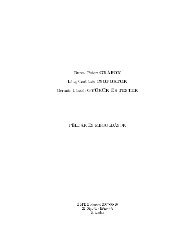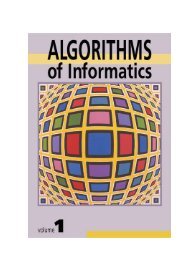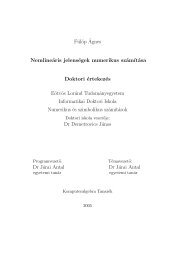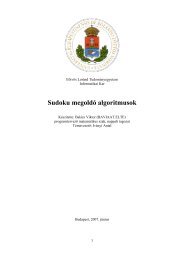On Erd˝os-Gallai and Havel-Hakimi algorithms
On Erd˝os-Gallai and Havel-Hakimi algorithms
On Erd˝os-Gallai and Havel-Hakimi algorithms
Create successful ePaper yourself
Turn your PDF publications into a flip-book with our unique Google optimized e-Paper software.
28 A. Iványi, L. Lucz, T. F. Móri, P. Sótér<br />
Lemma 17 Let b be a r<strong>and</strong>om n-regular sequence. Let us write it in the form<br />
b = (b e1<br />
1<br />
, . . . , ber<br />
r ). Then the expected value of the exponents ej is<br />
E[ej | r(b) ≥ j] = 4 + o(1). (47)<br />
Proof. Let c(n, j) denote the number of n-regular sequences with rainbow<br />
number not less than j. By Lemma 15,<br />
n<br />
<br />
n n − 1<br />
c(n, j) =<br />
. (48)<br />
k k − 1<br />
k=j<br />
k=j<br />
Let us turn to the number of n-regular sequences with rainbow number not<br />
less than j <strong>and</strong> ej = ℓ. This is equal to the number of (0, n−1, n−ℓ+1)-regular<br />
sequences containing at least j different numbers, that is,<br />
n<br />
<br />
n n − ℓ<br />
. (49)<br />
k k − 1<br />
From this the sum of ej over all n-regular sequences with ej > 0 is equal to<br />
n−j+1 <br />
ℓ=1<br />
ℓ<br />
n<br />
k=j<br />
<br />
n n − ℓ<br />
k k − 1<br />
= <br />
<br />
n<br />
n<br />
k<br />
k=j<br />
=<br />
n−j+1<br />
n<br />
k=j<br />
<br />
<br />
ℓ n − ℓ<br />
1 k − 1<br />
ℓ=1<br />
<br />
n n + 1<br />
= c(n + 1, j + 1). (50)<br />
k k + 1<br />
This can also be seen in a more direct way. Consider an arbitrary n-regular<br />
sequence with at least j + 1 blocks, then substitute the elements of the j + 1st<br />
block with the number in the jth block (that is, concatenate this two adjacent<br />
blocks) <strong>and</strong> delete one element from the united block; finally, decrease by 1<br />
all elements in the subsequent blocks. In this way one obtains an n-regular<br />
sequence with at least j blocks, <strong>and</strong> it easy to see that every such sequence is<br />
obtained exactly ej times.<br />
Thus the expectation to be computed is just<br />
c(n + 1, j + 1)<br />
.<br />
c(n, j)<br />
<br />
2n − 1<br />
Clearly, c(n, 1) = R(0, n − 1, n) = , hence<br />
n<br />
(51)<br />
<br />
2n − 1 j−1<br />
<br />
n n − 1 2n − 1<br />
<br />
c(n, j) = −<br />
= + O n<br />
n<br />
k k − 1 n<br />
2j−3<br />
, (52)<br />
k=1
















